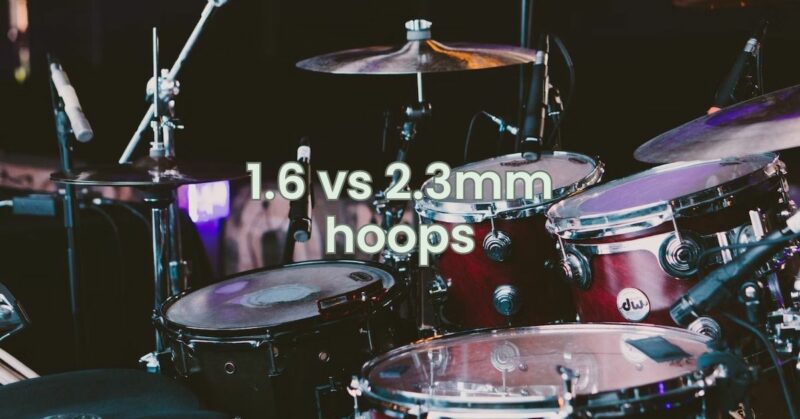Drum hoops play a crucial role in defining the sound and playability of a drum by influencing the tension and resonance of the drumhead. Among the various options available, 1.6mm and 2.3mm hoops are popular choices that offer distinct characteristics. In this article, we’ll delve into the differences between 1.6mm and 2.3mm drum hoops, exploring how each thickness affects the drum’s tone, tuning range, and overall performance.
Understanding Drum Hoop Thickness
- 1.6mm Drum Hoops:
- 1.6mm drum hoops are thinner and more flexible. They are often associated with a crisper, brighter sound with increased sensitivity.
- Thinner hoops allow the drumhead to vibrate more freely, resulting in a livelier response and a wider range of dynamic expression.
- 1.6mm hoops are favored by drummers who seek a balanced blend of attack, warmth, and resonance.
- 2.3mm Drum Hoops:
- 2.3mm drum hoops are thicker and more rigid. They provide a focused, controlled sound with enhanced projection and rimshot consistency.
- The increased rigidity of these hoops restricts the drumhead’s movement slightly, resulting in a more pronounced attack and defined tonal characteristics.
- 2.3mm hoops are often preferred by drummers in genres where projection, articulation, and volume are paramount, such as rock and metal.
Comparing Sound and Playability
- Tone and Resonance:
- 1.6mm hoops tend to produce a warmer, rounder tone with a broader range of overtones. They offer a harmonious balance between attack and sustain.
- 2.3mm hoops contribute to a brighter, more focused tone with reduced overtones. The sound is more controlled and defined.
- Sensitivity and Response:
- 1.6mm hoops provide increased sensitivity and responsiveness due to their thinner construction. Drummers can achieve nuanced dynamics and expressiveness.
- 2.3mm hoops offer a more controlled response with less drumhead movement. This can be advantageous for maintaining precision and projection during high-energy performances.
- Tuning Range:
- 1.6mm hoops generally offer a wider tuning range due to their flexibility. They allow for lower tunings while retaining resonance and warmth.
- 2.3mm hoops have a more limited tuning range but provide consistent tension across the drumhead. They excel in achieving higher tunings without sacrificing control.
- Rimshots and Attack:
- 1.6mm hoops contribute to softer rimshots with a slightly rounded attack. The sound is characterized by a blend of fundamental and overtones.
- 2.3mm hoops deliver more pronounced and defined rimshots with a sharper attack. The increased rigidity of the hoop enhances rimshot consistency.
Choosing the Right Hoop Thickness
- Genre and Playing Style:
- Consider the musical genres you play and the style of drumming you prefer. Choose a hoop thickness that aligns with the tonal qualities and dynamics required for your music.
- Tonal Preference:
- Visualize the desired sound you want from your drums. Do you lean towards a warmer, more resonant tone (1.6mm), or a focused, controlled sound (2.3mm)?
- Playing Dynamics:
- Evaluate how you express yourself on the drums. If you prioritize sensitivity and nuanced dynamics, thinner hoops might be suitable. For precision and projection, thicker hoops are advantageous.
Conclusion
The choice between 1.6mm and 2.3mm drum hoops is a significant consideration that directly impacts your drum’s sonic character and playability. Understanding the differences in tone, response, tuning range, and attack allows you to make an informed decision that aligns with your musical vision and drumming style. Whether you opt for the lively sensitivity of 1.6mm hoops or the controlled power of 2.3mm hoops, your choice will shape the way you express yourself through your drumming and create a unique sonic signature that resonates with your audience.


